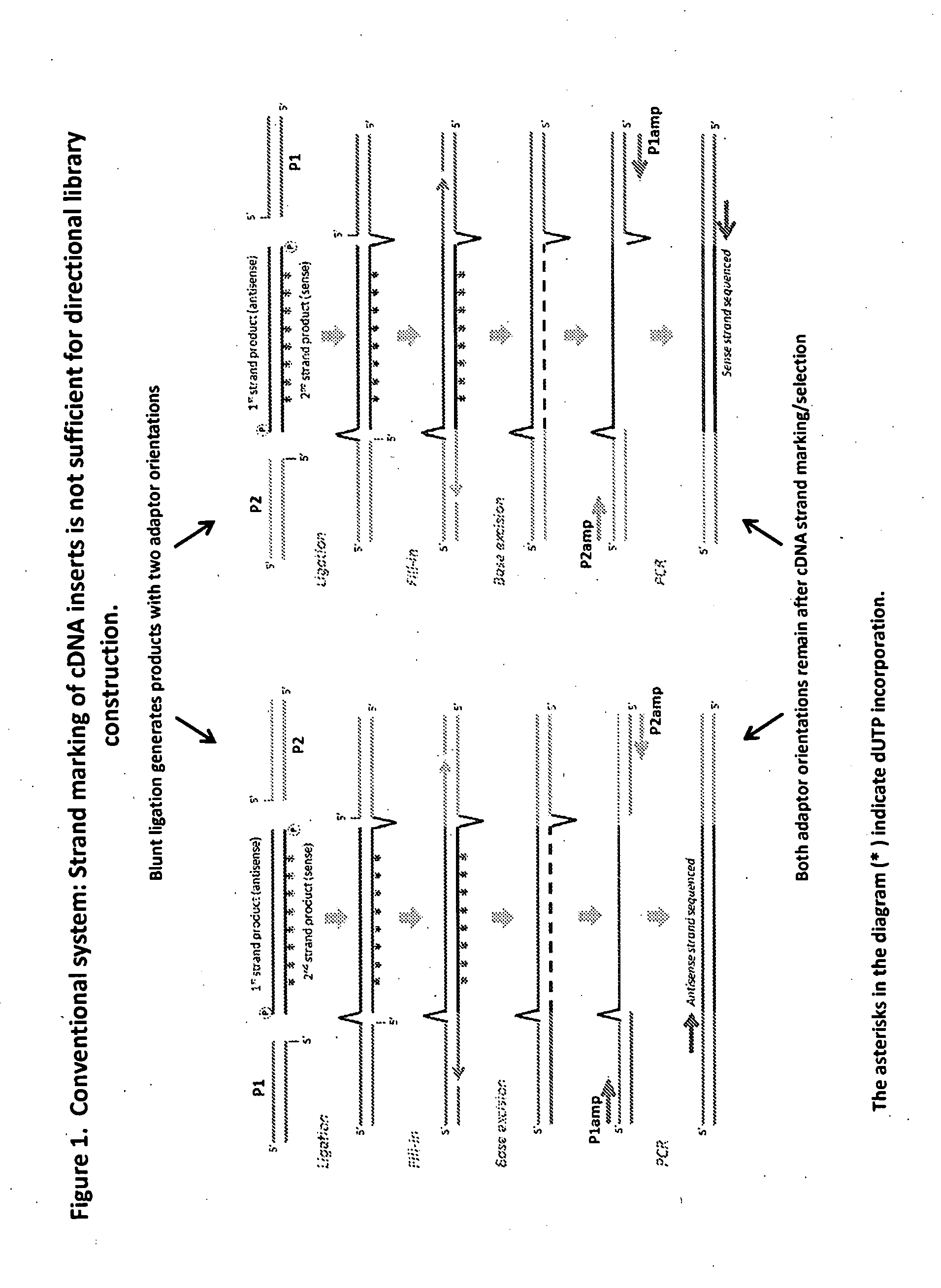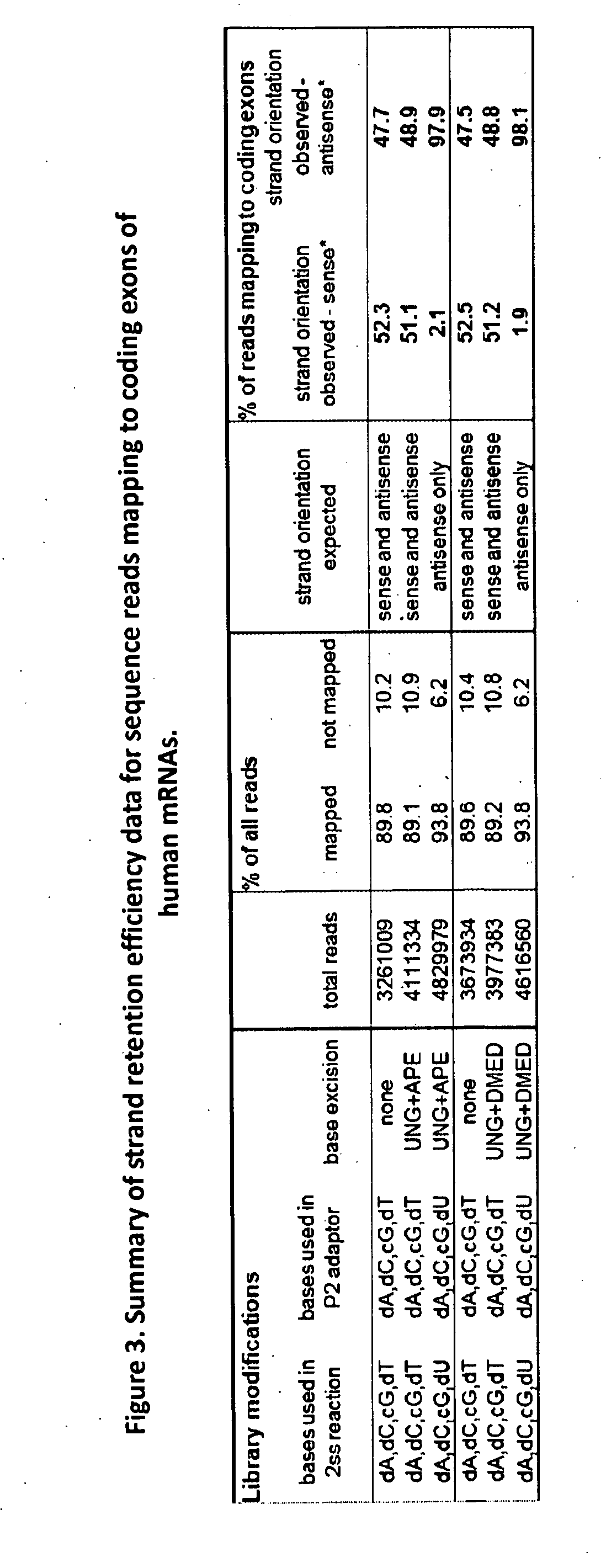Compositions and methods for directional nucleic acid amplification and sequencing
a nucleic acid and amplification technology, applied in the field of compositions and methods for directional nucleic acid amplification and sequencing, can solve the problems of loss of information as to which strand was present in the original rna template, loss of information on the direction of transcription, and preservation of directional information at the end of the cloned molecules
- Summary
- Abstract
- Description
- Claims
- Application Information
AI Technical Summary
Benefits of technology
Problems solved by technology
Method used
Image
Examples
example 1
Generation of a Directional cDNA Library
[0110]This example describes the generation of a directional cDNA library using conventional blunt-end ligation with modified duplex adaptors and 50 ng of poly(A)+ selected messenger RNA as a starting material. An overview of the end-end work-flow for the generation of the directional cDNA library is shown in FIG. 4.
[0111]First Strand Synthesis
[0112]First strand cDNA was generated using random hexamer priming. The first strand synthesis reaction was conducted using the Invitrogen SuperScript III Reverse Transcriptase kit, with 10 μM of random hexamers, 3.0 mM MgCl2 and 1.0 mM dNTPs. The cDNA synthesis reaction was carried out in 10 μL volume, incubated at 40 degrees Celsius for 60 minutes and chilled to 4 degrees Celsius.
[0113]Second Strand Synthesis with dUTP Incorporation
[0114]Second strand synthesis was performed using the New England Biolabs NEBNext Second Strand Synthesis Module, where the Second Strand Synthesis (dNTP-free) Reaction Buff...
example 2
RNA Strand Retention Efficiency
[0127]In this example, strand retention efficiency using the methods of the invention was validated experimentally by assessing the strand bias of sequence reads that map to the coding exons of human mRNAs. A directional cDNA library, as described in the invention, and a non-directional cDNA library (control) were generated from poly (A)+RNA isolated from human whole brain. Single end 40 nucleotide reads were generated using the Illumina Genome Analyzer II. Strand retention efficiency was measured by comparing the strand biases of sequence reads from the directional library and the non-directional control library. The results are presented in FIG. 3. After dUTP incorporation and UNG / APE I digestion of the strand with the undesired P2 / P1 adaptor orientation, 98% of reads from the directional cDNA library aligned to the correct (antisense) strand orientation, as compared to approximately 50% of reads in a non-directional control cDNA library.
example 3
RNA Strand Retention Efficiency
[0128]In this example, strand retention efficiency using the methods of the invention was validated experimentally by assessing the strand bias of sequence reads that map to the 5′ UTR and 3′ UTR regions of human mRNAs. Strand retention efficiency was measured as described in Example 2. The corresponding strand retentions for the directional library were 95% and 98% in the 5′ UTR and 3′ UTR regions, respectively, and 39% and 50% for the non-directional library.
PUM
| Property | Measurement | Unit |
|---|---|---|
| diameter | aaaaa | aaaaa |
| volume | aaaaa | aaaaa |
| nucleic acid sequences | aaaaa | aaaaa |
Abstract
Description
Claims
Application Information
 Login to View More
Login to View More - R&D
- Intellectual Property
- Life Sciences
- Materials
- Tech Scout
- Unparalleled Data Quality
- Higher Quality Content
- 60% Fewer Hallucinations
Browse by: Latest US Patents, China's latest patents, Technical Efficacy Thesaurus, Application Domain, Technology Topic, Popular Technical Reports.
© 2025 PatSnap. All rights reserved.Legal|Privacy policy|Modern Slavery Act Transparency Statement|Sitemap|About US| Contact US: help@patsnap.com



